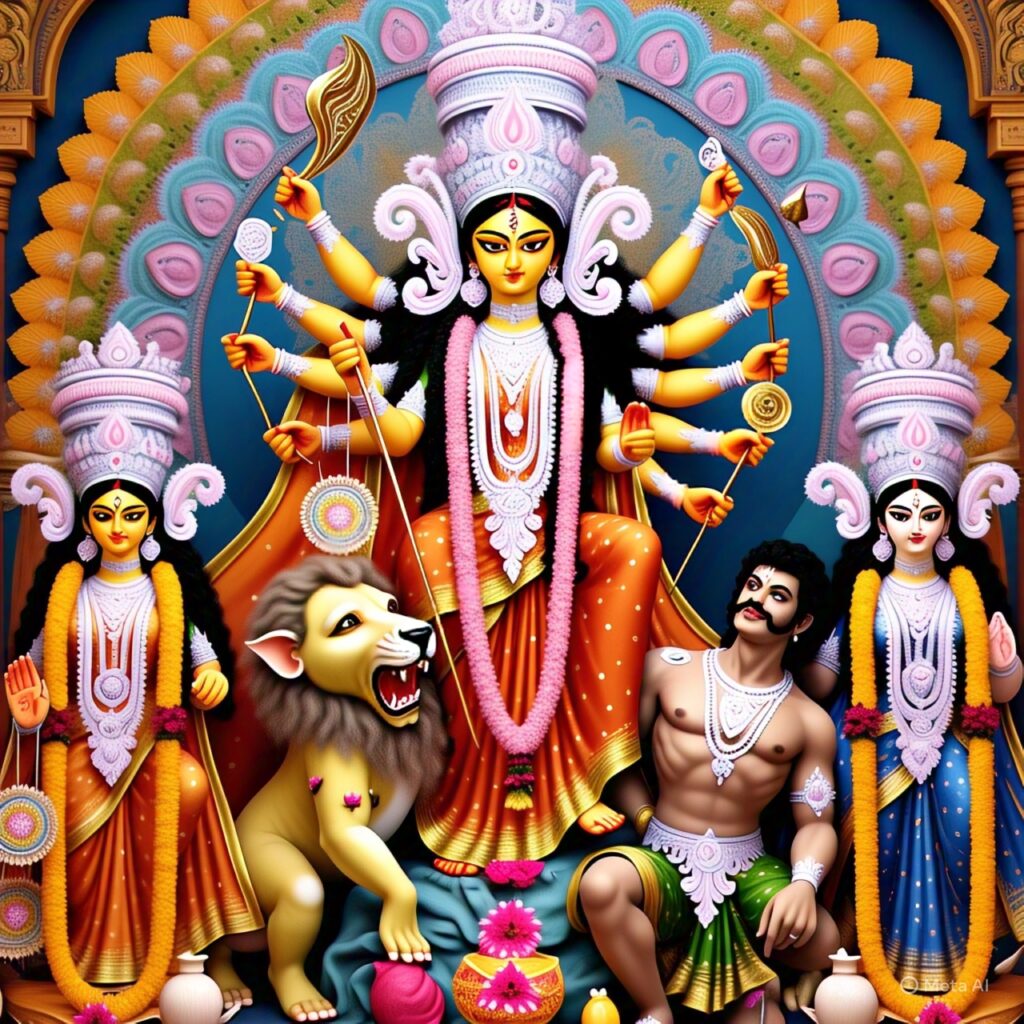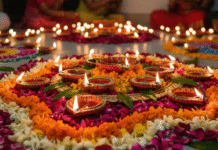
The Divine Feminine Energy Behind 9 Nights
Navratri,means in Sanskrit refers to “Nine Nights,” Navratri is one of the liveliest and most spiritually invigorated festivals of Hinduism. Its observance receives maximum devotion and grandeur in almost all Indian states, essentially an awakening of the spirit for the adoration of the Goddess, the embodiment of divine feminine energy, or Shakti. From the Garba dance in Gujarat to fasting and worshipping in Northern India, every ritual is an offering to the Goddess Durga and her nine divine forms.
But why is it that Navratri is celebrated? What does each of the nine nights symbolize? As old as it may be, how does this ancient tradition continue to inspire modern-day spirituality? Are you eager to know the story and the science behind it? Let us understand some of the deep reasons behind Navratri invoking Goddess Shakti.
Evolution of Navratri
🌀 Evolution of Navratri: A Celebration Beyond Seasons
Navratri, meaning “Nine Nights,” is celebrated not once but four times a year, aligning with key transitions in the Hindu lunar calendar. These include the Chaitra Navratri (spring), the most widely celebrated Sharad Navratri (autumn), and the two more spiritually intense yet lesser-known forms—Magha Gupt Navratri and Ashadha Gupt Navratri.
Each Navratri symbolizes the triumph of good over evil, the inner journey from darkness to light, and the empowerment of the feminine divine. For nine sacred nights, devotees invoke different forms of Goddess Durga, seeking blessings for health, prosperity, wisdom, and spiritual growth.
Chaitra and Sharad Navratris are public celebrations held in the spirit of fasting, rituals, and cultural events, while the Gupt Navratris are more esoteric and spiritual in observance, usually kept private by seekers who aim toward inner transformation and deeper sadhanas.
Whether celebrated with vibrant Garba nights or silent mantras in solitude, each Navratri is a gateway to awakening the divine feminine energy—Shakti—within us.
Mythological Origin: Why is Navratri Celebrated?
The origins of the Navratri festival draw from numerous legends of the Hindu scriptures.
1. The Battle of Durga and Mahishasura
The most widely celebrated legend pits Goddess Durga against the buffalo demon Mahishasura. Mahishasura, having been granted immortality by Lord Brahma with the condition that no man could kill him, wreaked havoc on Earth and Heaven. However, when the gods were unable to stop him, they offered him their combined energies to create Durga, who then battled Mahishasura for nine nights and ten days before eventually slaying him on the tenth day, which is celebrated as Vijayadashami or Dussehra.

2. Rama’s Worship of Durga
The second important story states that Lord Rama worshipped Goddess Durga for nine days before his actual war against Ravana and went on to win the war on the tenth day which is thus also known as Dussehra.
Both stories reaffirm the potency of Shakti, the divine feminine energy, in reinstating balance and righteousness to the universe.
The Importance of Nine Nights
Each of the nine nights of Navratri is dedicated to a different form of Durga, the collective name being Navadurga. Each of these goddesses represents different aspects of life, such as courage, knowledge, terror, and love.
Day Form of Durga Symbolism Color of the Day
Day 1 Shailaputri Root Chakra (Survival) Grey
Day 2 Brahmacharini Sacral Chakra (Discipline) Orange
Day 3 Chandraghanta Solar Plexus (Courage) White
Day 4 Kushmanda Heart Chakra (Love) Red
Day 5 Skandamata Throat Chakra (Parenthood) Royal Blue
Day 6 Katyayani Third Eye (Justice) Yellow
Day 7 Kalaratri Intuition & Fearlessness Green
Day 8 Mahagauri Purity and Peace Peacock Green
Day 9 Siddhidatri Spiritual Awakening Purple
The Nine Forms of Goddess Durga
Shailaputri – Daughter of the Mountains, she symbolizes strength and courage.
Brahmacharini – The ascetic form, representing devotion and penance.
Chandraghanta – Warrior goddess, ready for battle with her third eye open.
Kushmanda – Creator of the universe through her divine smile.
Skandamata – Mother of Kartikeya, the commander of gods.
Katyayani – Fierce and powerful, she destroys evil forces.
Kalaratri – Dark and fearsome, she eliminates ignorance and darkness.
Mahagauri – Radiant and peaceful, she cleanses all sins.
Siddhidatri – Bestower of spiritual knowledge and enlightenment.
Regional Variations in Navratri Celebrations
Region Celebration Style Key Rituals
Gujarat Garba & Dandiya Raas Night-long dance around a diya
West Bengal Durga Puja (from Day 6 to 10) Idols, pandals, Sindoor Khela
Tamil Nadu Golu (doll display), devotional songs Worship of Saraswati, Lakshmi, Parvati
Maharashtra Community prayers, fasting Haldi-Kumkum, family gatherings
Himachal Pradesh Kullu Dussehra begins on Dashami Cultural parades, fair, processions
The Feminine Energy (Shakti) and Its Spiritual Importance
In Hinduism, Shakti is the primal energy behind all creation, preservation, and destruction. While masculine deities are often associated with specific aspects (like Vishnu with preservation or Shiva with destruction), it is Shakti that empowers them all. She is the force behind the universe — unpredictable, creative, and nurturing.
Navratri serves as a reminder that the divine feminine is neither passive nor secondary; she embodies power, wisdom, and transformation itself. It invites us to honor not just the goddesses in temples, but also the women surrounding us, and the feminine energy which lies in each one of us-regardless of gender.
Navratri Fasting and Rituals: A Path to Purification
Fasting in Navratri is not only a religious act, It has now become a form of spiritual detox. By consuming sattvic food, such as fruits, milk, and nuts, devotees cleanse the body, calm the mind, and heighten their spiritual vibrations. Chanting the mantra “Ya Devi Sarva Bhuteshu Shakti Rupena Samsthita,Namastasyai Namastasyai Namastasyai Namo Namah“(To the Divine Goddess who resides in all beings in the form of Shakti (power/energy),I bow to her again and again and again.) lighting of lamps, and meditating on the goddess assists in internal transformation.
Some key benefits of Navratri fasting:
Enhances focus and spiritual clarity
Balances bodily energies[the concept of energy balance, which is the balance of net energy (calories) consumed by a person and then expending that energy through various metabolic functions and physical activity]
Builds discipline and inner strength
Conclusion: Awakening the Shakti Within
Navratri is a timeless spiritual festival. It represents a personal spiritual journey for each devotee. Every night is a step toward internalization, purification, or empowerment. As the lamps glow and mantras resonate, we should be reminded of the fierce yet motherly energy of the Goddess who lives not only in the heavens but also in us.
Thus, while Navratri is being celebrated this year, one should not only worship the divine-feminine, but also embody her strength, wisdom, and grace. The true purpose of Navratri is to awaken that Shakti within you.






